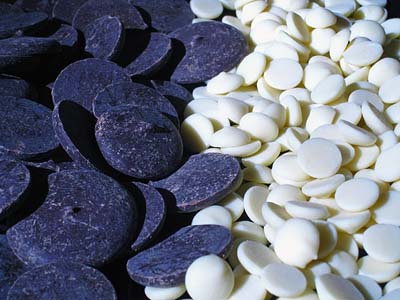Ah, chocolate. The folks who love it, really love it, and it’s easy to see why. In its most readily available incarnation, it is silky smooth and intriguingly flavored, with seemingly endless variety. It melts at just below body temperature, so popping a piece in your mouth and letting it melt at its own pace allows you to experience the full breadth of its flavor and luxurious texture. It can be enjoyed on its own or incorporated (in solid or melted form) into any number of glorious confections.

Chocolate begins its life as the seeds of the tropical cacao plant. These seeds (called cocoa beans) are removed from their pods, fermented, dried, roasted, removed from their hard outer shells, and ground into chocolate liquor - a suspension of cocoa bean solids in cocoa butter (the highly saturated fat that is mashed from the beans). This can be solidified into unsweetened chocolate. Bittersweet and semisweet chocolates are made from varying mixtures of chocolate liquor, sugar, emulsifiers, and sometimes vanilla. When milk is also added to the mix, milk chocolate is achieved. Generally speaking as more of these other ingredients are added, the cacao content goes down finally landing you at white chocolate, which (if it’s genuine) contains only the cocoa butter component of the cacao plant. Containing zero chocolate liquor (the reason it’s generally not considered to be chocolate at all), its flavoring is derived from sugar, milk, and vanilla.
Stored at room temperature, dark chocolate will keep for a number of years. Thanks to their milk content, however, milk chocolate and white chocolate should be stored for no longer than roughly 6-9 months. Chocolate can scorch quite easily. For that reason, if your intention is to melt you chocolate, some care must be taken. First, either purchase the chocolate in chips, disks, or feves. If that isn’t possible and a large chunk must be procured instead, chop it up into maneuverable pieces before melting. Chocolate can be melted in a double boiler (which you can create on your own by heating water to boiling in a small pot, reducing the meat to maintain a simmer, setting a heat-resistant bowl on top of that making sure it doesn’t touch the water, and stirring your chocolate chunks in the now gently heated bowl. A second method which I’ve grown quite fond of is to heat the chips at reduced power in the microwave, carefully stirring them every 20-30 seconds. You want to give up on the microwave when your chocolate is about half melted and then just continue to stir it till the remainder of the chocolate melts.